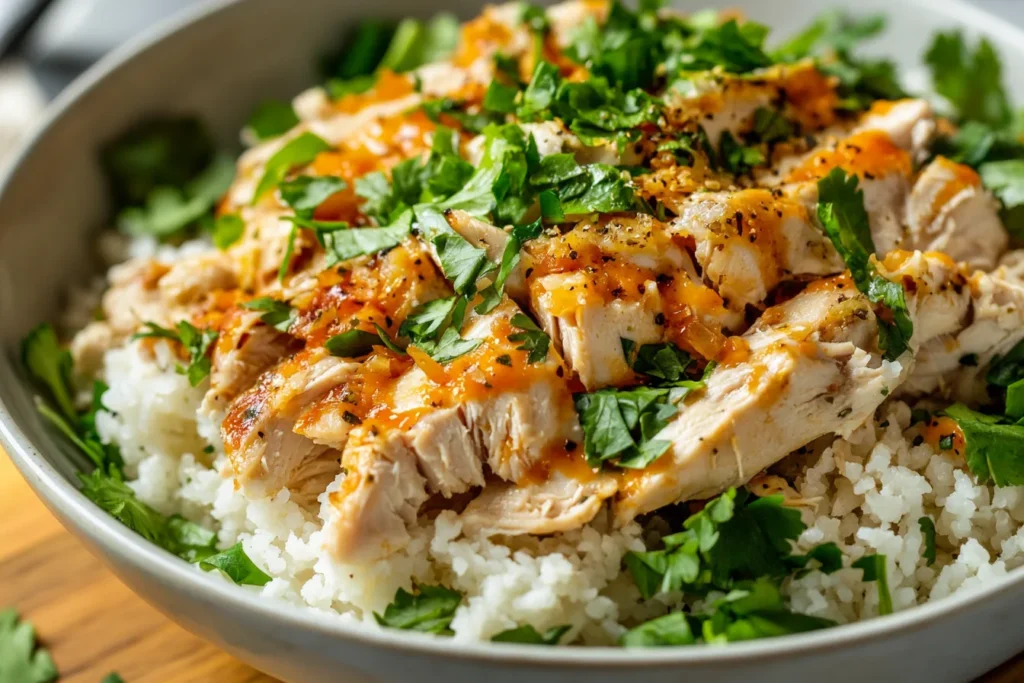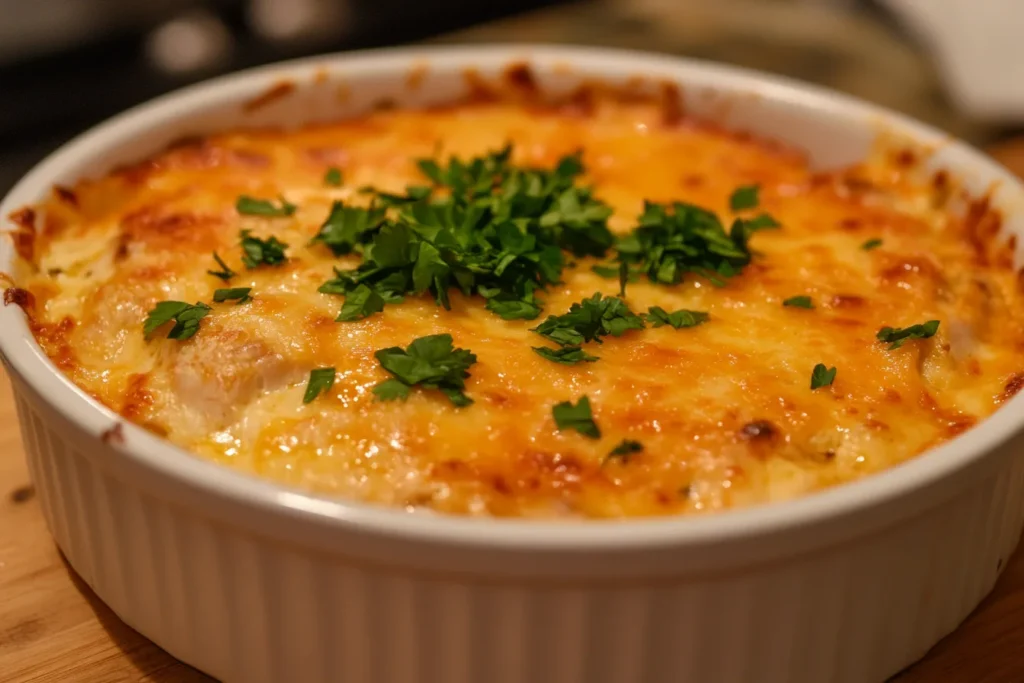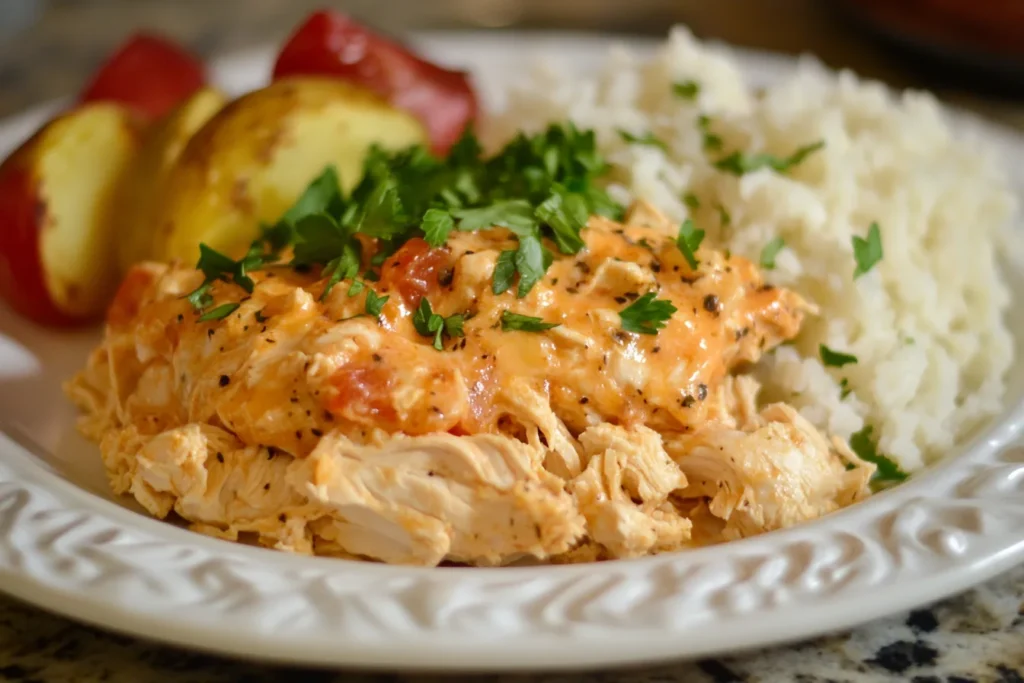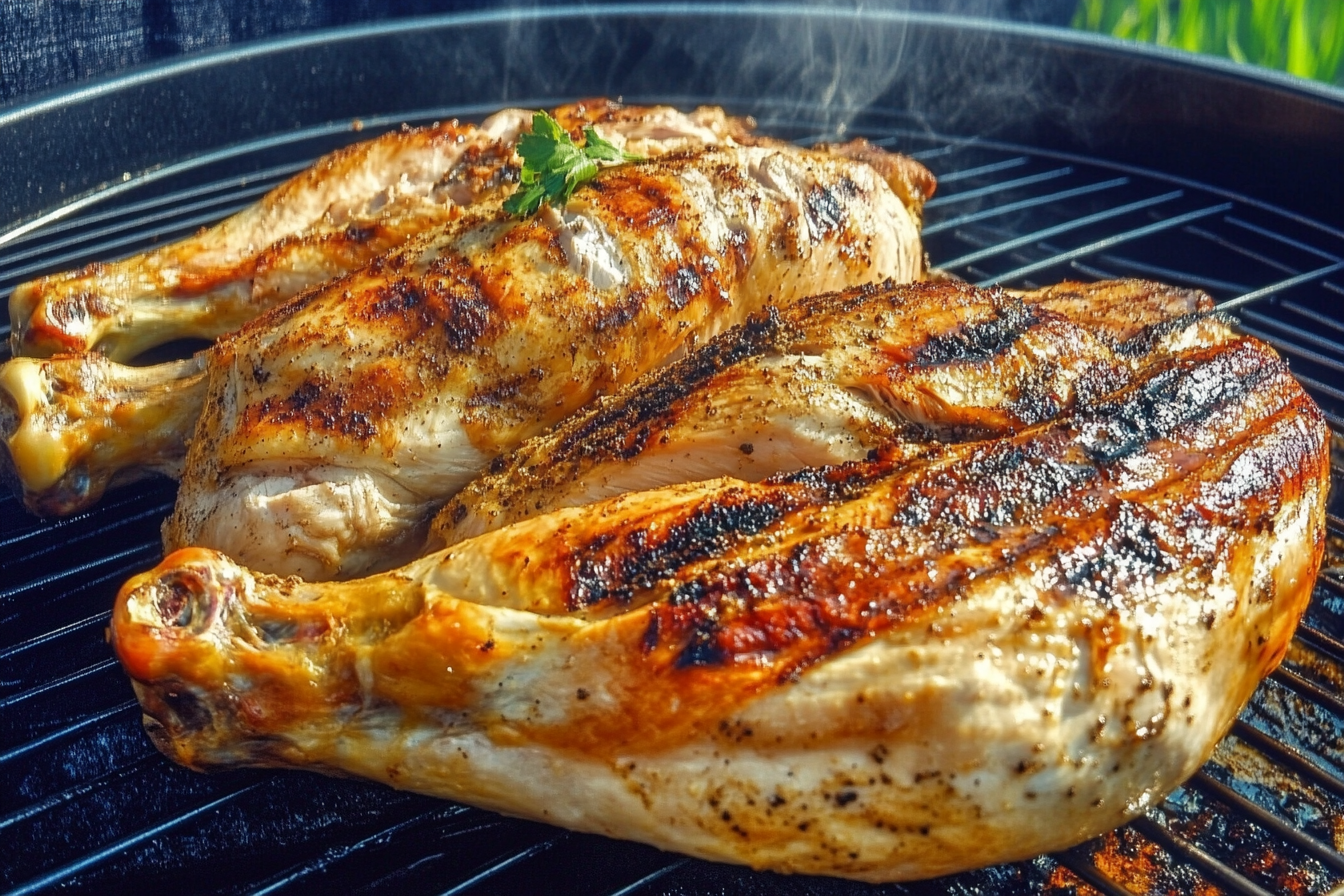Understanding Leftover Rotisserie Chicken
Leftover rotisserie chicken is a lifesaver for quick meals, but it can lose its juiciness if not handled correctly. Whether you’re preparing a sandwich, soup, or casserole, ensuring your chicken remains moist is key to a delicious dish.
Here’s how to bring life back to your leftover rotisserie chicken.

Why Does Rotisserie Chicken Dry Out?
Rotisserie chicken dries out for a couple of reasons:
- Moisture loss during refrigeration: As the chicken cools, its natural juices solidify and separate, leaving the meat less succulent.
- Improper reheating: Overheating or using dry cooking methods can strip away the remaining moisture.
When you understand these causes, you can take simple yet effective steps to restore juiciness.
Common Mistakes When Reheating Rotisserie Chicken
Avoid these pitfalls to keep your chicken moist:
- Using a microwave without protection: Heating chicken without covering it leads to rapid moisture evaporation.
- Skipping the liquids: Dry reheating methods, like broiling or baking without a sauce or broth, exacerbate dryness.
- Reheating for too long: Overcooking toughens the meat, making it chewy and dry.
Importance of Moisture Retention in Cooked Chicken
Maintaining moisture not only enhances the flavor but also improves the texture of the chicken. A moist piece of meat complements dishes better, ensuring you enjoy a satisfying meal every time.
Key Ingredients to Restore Moisture to Rotisserie Chicken
Adding moisture back into leftover chicken involves using ingredients that naturally hydrate and flavor the meat.
Broth and Stock: The Ultimate Moisture Enhancer
Chicken broth or stock is the gold standard for reviving dry meat. Here’s why:
- Rich in flavor: Broth infuses chicken with deep, savory notes.
- Perfect consistency: The liquid easily seeps into the meat, restoring moisture without making it soggy.
To use, warm up the broth and pour it over shredded or sliced chicken before reheating.
Using Butter or Oil for Rehydration
Butter and oils are excellent for:
- Locking in moisture: Their fats coat the meat, preventing it from drying further.
- Adding richness: They enhance the natural flavors of chicken.
Brush melted butter or olive oil over the chicken before warming it up in the oven.
Spices and Sauces That Keep Chicken Juicy
Spices like paprika, garlic powder, and onion powder paired with sauces—such as barbecue or teriyaki—add a moist layer to the chicken. The trick is to combine spices with liquid bases for maximum flavor and hydration.
Choosing Between Homemade and Store-Bought Moisture Enhancers
When possible, opt for homemade stock or sauces. They are free from preservatives and rich in natural flavors. However, store-bought options can work well if time is tight. Always check for low-sodium varieties to avoid overly salty results.

Kitchen Tools for Reheating Leftover Chicken
Reheating chicken effectively requires the right tools. Here are some essentials:
- Microwave-safe containers with lids: Traps steam, preventing dryness.
- Non-stick pans: Ideal for stovetop reheating with added liquids.
- Oven-safe dishes with foil: Keeps heat and moisture evenly distributed during baking.
Each tool plays a role in helping your chicken regain its lost juiciness.
Techniques to Make Leftover Rotisserie Chicken Moist
Reheating Methods That Retain Moisture
When reheating leftover rotisserie chicken, choosing the right method is critical to maintaining its texture and flavor. Below are the best methods to ensure your chicken stays juicy and tender.
Stovetop Method: Step-by-Step Guide
The stovetop method is ideal for reheating smaller portions quickly:
- Prepare a liquid base: Use chicken broth, water, or a sauce of your choice.
- Heat the pan: Use medium-low heat and add a small amount of oil or butter.
- Add the chicken: Place the chicken pieces into the pan, ensuring they don’t overlap.
- Cover and heat gently: Cover the pan with a lid to trap steam and infuse moisture.
- Flip and baste: Turn the chicken halfway through and baste it with the warmed liquid for added juiciness.
This method ensures even heating and rehydration without overcooking.
Oven Method: Low and Slow for Best Results
For reheating larger portions or an entire chicken, the oven is the best option:
- Preheat the oven: Set it to 300°F (150°C).
- Prepare the chicken: Place it in an oven-safe dish and add chicken broth or sauce to the base.
- Cover with foil: Sealing the dish tightly prevents moisture from escaping.
- Reheat gradually: Warm the chicken for 20-25 minutes, checking periodically to avoid overcooking.
Low heat allows the chicken to reabsorb the liquids, making it tender and flavorful.
Microwave Tips for Quick Reheating Without Drying Out
While the microwave is fast, it can easily dry out chicken if done improperly. Follow these tips:
- Add a moisture source: Use a tablespoon of broth or water for each portion.
- Cover tightly: Use a microwave-safe lid or plastic wrap to trap steam.
- Reheat in short intervals: Heat in 30-second bursts, stirring or flipping the chicken between intervals.
This ensures the chicken heats evenly without losing moisture.
Incorporating Liquids to Enhance Moisture
Using liquids effectively can transform dry chicken into a juicy delight.
Adding Chicken Stock or Gravy Before Reheating
Chicken stock or gravy works wonders for restoring moisture and flavor. Here’s how to use them:
- For shredded chicken: Submerge the pieces in warm stock before reheating.
- For whole pieces: Drizzle the liquid over the meat and let it soak for 10 minutes prior to heating.
This step prevents dryness and adds depth to the taste.
Using Wine or Citrus Juice for Flavorful Moisture
For a more gourmet twist, try wine or citrus juice:
- White wine: Adds subtle acidity and enhances savory notes.
- Citrus juice: Lemon or lime juice pairs well with herbs and gives a refreshing zing.
Mix these liquids with olive oil or butter for a balanced moisture boost.
Steam Cooking Techniques for Rehydration
Steaming is an underrated method for reheating chicken:
- Set up a steamer basket: Place chicken in the basket above simmering water.
- Cover and steam: Heat for 5-7 minutes, checking for even reheating.
The steam gently rehydrates the chicken while maintaining its natural texture.
Resting and Slicing Techniques to Retain Juiciness
Proper handling after reheating can make a significant difference in the chicken’s texture.
Allowing the Chicken to Rest After Reheating
Once reheated, let the chicken rest for 5-10 minutes before slicing or serving. Resting allows:
- Redistribution of juices: Prevents them from escaping when the meat is cut.
- Better texture: Rested chicken feels more tender and satisfying to eat.
Slicing Chicken the Right Way
Always slice chicken against the grain. This breaks down muscle fibers, making each bite more tender and enjoyable. Use a sharp knife for clean cuts.
Creative Recipes to Repurpose and Moisturize Leftover Rotisserie Chicken
Soups and Stews: Perfect for Rehydrating Dry Chicken
Leftover rotisserie chicken shines in soups and stews. The liquid-heavy dishes naturally rehydrate the meat while enhancing its flavor.
Chicken Noodle Soup with a Twist
This classic comfort dish gets a boost with your leftover chicken:
- Ingredients: Chicken stock, shredded rotisserie chicken, egg noodles, carrots, celery, garlic, and fresh herbs like parsley.
- Preparation:
- Sauté vegetables in a pot with olive oil or butter.
- Add chicken stock and bring to a simmer.
- Stir in noodles and shredded chicken.
- Cook until the noodles are tender and the chicken is heated through.
This twist adds depth with fresh herbs and ensures the chicken is both moist and flavorful.
Creamy Chicken Stew for Ultimate Comfort
Transform your rotisserie chicken into a hearty stew:
- Ingredients: Rotisserie chicken, cream, chicken stock, potatoes, peas, onions, and flour for thickening.
- Steps:
- Sauté onions and potatoes until soft.
- Stir in flour for a thick base and add chicken stock.
- Simmer until the mixture thickens, then fold in shredded chicken and cream.
This creamy stew envelops the chicken in a luscious sauce, ensuring it stays tender.

Casseroles and Bakes: Combining Ingredients for Moisture
Casseroles are perfect for using up leftover chicken, combining it with sauces, cheese, and other moisture-rich ingredients.
Chicken Pot Pie with Gravy-Infused Chicken
A pot pie transforms leftover chicken into a decadent, flaky treat:
- Ingredients: Rotisserie chicken, premade pie crust, mixed vegetables, chicken gravy, and cream.
- Instructions:
- Mix shredded chicken with gravy and vegetables.
- Pour the mixture into a pie dish and cover with a pie crust.
- Bake at 375°F (190°C) until golden brown.
The gravy ensures the chicken stays moist and flavorful throughout the baking process.
Rotisserie Chicken Enchiladas with Creamy Sauce
These enchiladas are both easy and packed with moisture:
- Ingredients: Shredded chicken, tortillas, enchilada sauce, sour cream, and shredded cheese.
- Method:
- Combine chicken with a mixture of enchilada sauce and sour cream.
- Fill tortillas with the chicken mixture, roll, and place in a baking dish.
- Cover with more sauce and cheese, then bake until bubbly.
This dish guarantees a juicy bite in every tortilla.
Salad and Sandwich Ideas with a Moisture-Rich Base
Leftover chicken is ideal for cold dishes, as long as you incorporate hydrating ingredients.
Chicken Salad with Yogurt or Mayonnaise
Chicken salad is a refreshing way to use rotisserie chicken:
- Ingredients: Shredded chicken, Greek yogurt (or mayo), celery, grapes, and nuts.
- Preparation:
- Mix chicken with yogurt or mayonnaise for a creamy base.
- Add chopped celery and grapes for crunch and sweetness.
Serve it over greens or in a sandwich for a delicious, moist dish.
Rotisserie Chicken Panini with Cheese and Sauces
A warm, cheesy panini can breathe new life into your chicken:
- Ingredients: Sliced chicken, mozzarella cheese, pesto sauce, and artisan bread.
- Steps:
- Spread pesto on the bread, layer with chicken and cheese, and grill until crispy.
The melted cheese and sauce keep the chicken juicy and flavorful.
Storage and Freezing Tips to Preserve Moisture
Proper storage of leftover rotisserie chicken prevents it from drying out, even before reheating.
How to Properly Wrap and Store Leftover Rotisserie Chicken
- Wrap tightly: Use aluminum foil or plastic wrap to keep air out.
- Use airtight containers: Store chicken in a container with a tight seal to reduce moisture loss.
- Refrigerate promptly: Place the chicken in the fridge within two hours of cooking to maintain freshness.
Freezer Techniques to Prevent Dryness
Freezing leftover chicken can preserve its moisture if done correctly:
- Freeze in portions: Divide chicken into meal-sized portions to make reheating easier.
- Add broth before freezing: Pour a small amount of chicken broth over the meat to lock in moisture.
- Use freezer-safe bags: Remove as much air as possible before sealing.
When reheated, frozen chicken will be as tender as freshly cooked.
FAQs
Here are answers to common questions about reviving leftover rotisserie chicken:
- Can I microwave chicken without drying it out?
Yes, by covering it and adding a tablespoon of broth or water for each portion. - How long should I reheat chicken in the oven?
Reheat at 300°F (150°C) for 20-25 minutes with added broth or sauce. - What’s the best liquid for moistening chicken?
Chicken stock or broth is the best choice for flavor and moisture. - Can I use frozen chicken directly in recipes?
It’s best to thaw frozen chicken overnight in the refrigerator for even reheating. - Why does chicken get rubbery in the microwave?
Overheating causes protein fibers to contract, leading to a tough texture. - Is steaming chicken better than reheating in the oven?
Steaming is gentler and ensures the chicken retains more moisture. - What spices pair well with leftover chicken?
Garlic powder, paprika, cumin, and herbs like thyme enhance flavor without overpowering. - How long can I store leftover rotisserie chicken?
Store in the fridge for up to 3-4 days or freeze for up to 3 months. - Can I add cold rotisserie chicken to salads?
Yes, but mix it with yogurt or mayo to keep it moist. - What’s the quickest way to reheat rotisserie chicken?
The microwave is fastest, as long as you cover it and add a liquid.
Related Article :What is the secret ingredient in rotisserie chicken?

